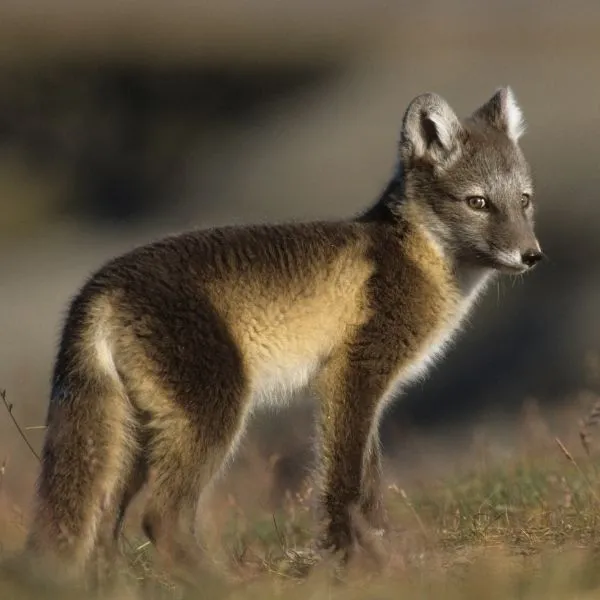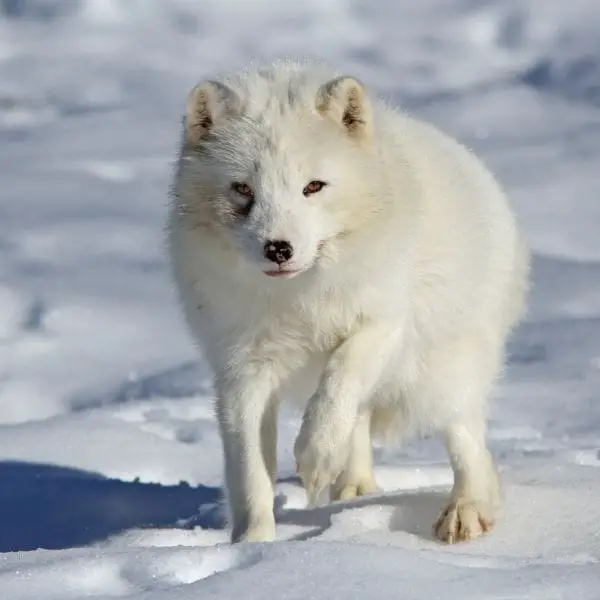Arctic Fox Fur Color Change
The arctic play tricks (vulpes lagopus) is a pocket-sized fox found in the northern hemisphere. They alive in cold climates and are well adjusted to frigid environments. Information technology's a well-known fact near arctic foxes that they are white to blend in with the snowy white arctic mural, but what happens to them in the summer when parts of the tundra melt. Do arctic foxes change colour?
Yes, arctic foxes change the color of their fur depending on the flavour which makes it harder for predators to spot them. The chill play tricks's glaze color will be white during winter months to blend in with the snow, then they volition switch to earthy tones such as brown or grey during summertime months.
Keep reading to find out why and how they change the color of their fur coat and some other adaptions they make to help them survive.
- Does an Chill Fox Modify Color?
- How Do Arctic Foxes Modify Colour?
- When Exercise Arctic Foxes Alter Colour?
- Why Exercise Arctic Foxes Have Thick Fur?
- The Issue of Climate Change on Arctic Foxes
Does an Arctic Fob Change Color?
Watch the video version here or scroll down to continue reading:
Arctic foxes are best known for their thick white fur that helps them blend in with the snow of the arctic and ice floes. This provides camouflage to protect them from their predators.
However, every bit the snow melts in the warmer months of the year and they migrate to areas with less snowfall, they don't continue their white fur as this would make them too obvious to predators.
Instead, arctic foxes shed their white glaze for more earthy tones such as chocolate-brown, grey, or sometimes even red fur. This helps information technology camouflage against the vegetation and rocky terrain in the tundra and the edges of forests where they can be plant in summertime1 (source: National Geographic YouTube Channel).
Equally well as changing the color of their coat, they also change the thickness to help with insulation, but more on this later.
However, one variant known as the blue morph arctic play a trick on does not abound a white winter coat. Although it does still modify colour slightly, from a dark gray/blueish coat in summer to a lighter grayness coat in winter2 (source: PubMed, DI Våge, et al, 2005). The blue morph arctic play a joke on is very rare with estimates putting the population of blue morphs betwixt ane-3% of the full arctic play a joke on population3 (source: Norwegian Polar Institue).
Most of the arctic animals you know will keep the colour of their fur twelvemonth-round such as the polar bear and snowy owls. However, chill foxes aren't alone in changing colour between seasons. Both the arctic hare and the stoat have a white glaze in winter to meliorate camouflage confronting the snowfall4 (source: National Geographic).
How Practise Chill Foxes Change Color?
Seasonal molting occurs in around 21 dissimilar species from 5 families of birds and mammals and all work in a similar mode whether information technology is feathers or fur.
The colour variation is adamant by melanin pigments which are responsible for giving arctic foxes their brown/grey colour during summer5 (source: Italian Journal of Animal Science, J Bao, et al, Vol 14, Issue 3, 2015).

Yous'll observe variations in the summer coat colour of arctic foxes depending upon where they live. For example, those in wooded areas may be more red/brown whereas those in rocky areas may be more grey to help them blend in.
This is because there are ii types of melanin pigment – eumelanin and phaeomelanin.
Eumelanin results in blackness/dark-brown colors whereas phaeomelanin results in yellow/ruddy colors. Arctic foxes in different areas will have a unlike ratio of the two which has evolved over fourth dimensionhalf-dozen (source: Biological Reviews, Grand Zimova, et al, vol 93, Issue iii, Aug 2018).
When Do Arctic Foxes Change Colour?
Arctic foxes molt their white winter coat effectually May in favor of their thinner brown/grey summertime glaze. This lasts them through the summer months until they begin growing their white winter coat over again in September7 (source: PubMed, DI Våge, et al, 2005).
Information technology tin can accept several months for them to fully grow their winter coat and it may not reach full length until early December.

Why Do Arctic Foxes Have Thick Fur?
Arctic foxes take adjusted to life in the farthermost conditions of the chill tundra by being able to live with little nutrient and water, having thick fur for insulation, and white fur so they can blend into their surroundings. This means that arctic foxes do not need to hibernate or migrate.
Their winter fur is 200% thicker than their summer fur8 (source: PubMed, DI Våge, et al, 2005) and at a microscopic level contains more air which makes them more effective at keeping the fox warm.
At that place accept been suggestions that the white fur loses less heat via radiation although this has never been provennine (source: Biological Reviews, Chiliad Zimova, et al, vol 93, Consequence 3, Aug 2018).
They also abound additional pilus on their anxiety for better insulation and traction during snowy seasons, having lots of hair on their feet helps to preclude slipping as they race across the icy terrain10 (source: National Geographic).
Their thick busky tail is besides useful for keeping warm in winter and like to cats is used to assistance them maintain balance.
The Result of Climate change on Arctic Foxes
Climate change is having an impact on the habitat of the chill, notably the melting of snow which has resulted in chill foxes condign endangered in some regions of Fennoscandia. This can result in a mismatch betwixt the color of their winter glaze and their surroundings.
This makes their camouflage less effective and can result in them condign more susceptible to predators. It likewise has an impact on their ability to catch food as they utilise cover-up to sneak upwardly on their casualty. This is one of the reasons why ruddy foxes are flourishing in areas previously dominated past arctic foxeseleven (source: Climate Change Biology, 50 Hannah, 2011).
Scientists expect that arctic foxes will adapt the colour of their wintertime coat over time (by natural selection) or may even lose their winter glaze altogether12 (source: Biological Reviews, Yard Zimova, et al, vol 93, Upshot 3, Aug 2018).
Arctic Fox Fur Color Change,
Source: https://polarguidebook.com/do-arctic-foxes-change-color/
Posted by: wrightsagessay.blogspot.com


0 Response to "Arctic Fox Fur Color Change"
Post a Comment